|
|
|
| My Favourite Planet > English > Middle East > Turkey > Pergamon > gallery 2 |
| Pergamon gallery 2 |
Pergamon art |
 |
 |
14 of 26 |
 |
 |
|
| |
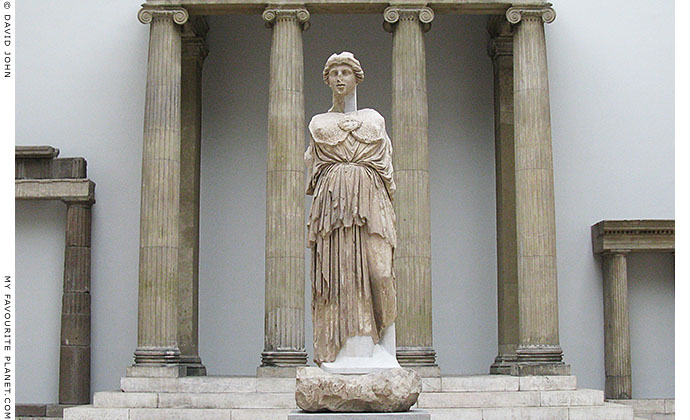
Statue of Athena Parthenos from the Library of Pergamon. Now in the Pergamon Museum, Berlin. |
| |
The Hellenistic statue of Athena Parthenos (Greek, Ἀθηνᾶ Παρθένος, Athena the Virgin), was made about 200-150 BC of Pentelic marble (from Mount Penteli, Athens). It was found at the end of 1880 among the rubble at the east end of the Library of Pergamon, in the precinct of Athena Polias Nikephoros (Athena of the City, Bringer of Victory) on the Acropolis. [1]
The restored sculpture now stands in the Pergamon Museum, Berlin, in a room exhibiting emormous parts of architectural monuments from Pergamon and other ancient cities in Asia Minor, including the propylon of the Pergamon Sanctuary of Athena Nikephoros (see gallery 2, page 20). In the photo above the statue stands in front of the reconstructed western front of the 2nd century BC Temple of Zeus Sosipolis from Magnesia on the Maeander, Turkey.
The 310.5 cm tall figure is missing the left side of the neck, the feet as well as both arms. The reconstruction has been been given a neck which appears far too long in proportion to the head and body. The remains of the base on which the figure stands is 40.5 cm high, 118.5 cm wide, 69 cm deep, made from a single block of marble (see photo below). It is thought to have originally been about twice as large: 266 cm long and 133 cm deep.
The statue was modelled on the colossal Athena Parthenos statue, made of a wooden core covered in gold and ivory (chryselephantine), by the Athenian sculptor Pheidias around 450-430 BC, which stood in the Parthenon of the Athenian Acropolis.
Although Pheidias' original is lost, two small copies, known as the "Varvakeion statuette" and "Lenormant Athena", in the National Archaeological Museum, Athens (see photos below), and other copies found around the Graeco-Roman world provide modern scholars with an idea of how it looked.
This is how the Greek travel writer Pausanias described the statue in the Parthenon, as he recalled seeing it in the mid 2nd century AD:
"The statue itself is made of ivory and gold. On the middle of her helmet is placed a likeness of the Sphinx... and on either side of the helmet are griffins in relief...
The statue of Athena is upright, with a tunic reaching to the feet, and on her breast the head of Medusa is worked in ivory. She holds a statue of Victory about four cubits high, and in the other hand a spear; at her feet lies a shield and near the spear is a serpent. This serpent would be Erichthonius.
On the pedestal is the birth of Pandora in relief. Hesiod and others have sung how this Pandora was the first woman; before Pandora was born there was as yet no womankind." [2]
Strangely, Pausanias did not mention the name of the sculptor who made the statue, although elsewhere he mentioned that other statues in Athens were made by Pheidias. Although he wrote that the statue held a spear in her left hand, the Varvakeion and Lenormant statuettes show her holding the shield decorated with a complex relief of a battle scene, and sheltering a large serpent. In the palm of her outstretched right hand, supported by a column, she held a small winged figure of the goddess Nike, who in turn held out the laurel wreath of victory.
In the Pergamon Athena Parthenos and other copies the goddess wears an Attic helmet. Pausanias mentions that the original was decorated by a sphinx flanked by two griffins, but the Varvakeion statuette has three crests, each supported by a sphinx and two winged horses, or pegasoi.
This type of helmet also had cheek flaps (see the photo of the "Medici Athena", below right). A photo of the Pergamon statue, taken around 1913 (see below), shows raised cheek flaps attached to the helmet. These seem to have since disappeared.
As in the Varvakeion statuette and many other similar statues of Athena, her shoulders and breast are covered by a breastplate or aegis, which in this case appears to be covered by vertically layered feathers or scales, fastened at the front by the Gorgoneion, the head of the Gorgon Medusa.
Numerous holes were drilled in the figure by the sculptor (see photo, right) so that details and adornments could be fixed to it with dowels.
The front of base is decorated with a 15 cm high relief, decorated with a row of figures (see photo below). Although badly damaged, parts of seven figures are still visible, and it seems that the surviving part of the relief could not have had space for more than ten figures. The Roman writer Pliny the Elder also wrote that the pedestal of Pheidias' original depicted the birth of Pandora and that it included 20 gods; if the image of Pandora herself is added to this number, there must have been 21 figures in total. [3]
When compared to the statue of "Athena with the cross-banded aegis" (see previous page), this work seems more conventional and static. Her posture, for example, is totally rigid and erect, with only the slightly raised and bent left leg and (presumably) arms to provide dynamic elements.
Both sculptures were created around the same time, during the first half of the 2nd century BC, so that while the artist working on the other statue was creating something quite new and innovative, the maker of this copy of a Classical Athenian original was providing the Hellenistic city with a sacred image famous throughout the Hellenic world, which was thus a claim to cultural continuity and a symbolic link to the ancient Greek motherland.
Since the statue is thought to have stood in the Pergamon Library (Athena was a patron goddess of learning and the arts), perhaps it was considered even in Hellenistic times as much as a museum piece as a sacred image. |
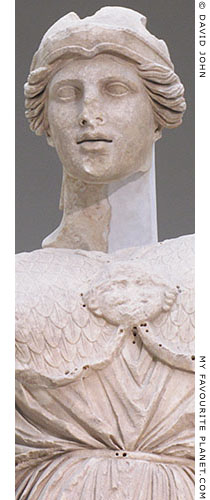
Detail of the Athena
Parthenos statue. |
| |
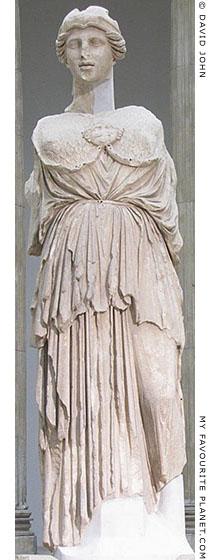
Athena Parthenos, full length. |
| |
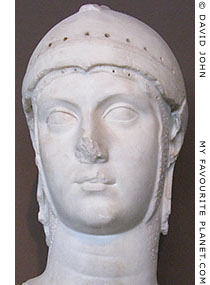
Head of Athena of the
"Medici type", copied from
works by the circle of
Pheidias. The goddess
wears an Attic helmet
with cheek flaps.
2nd century AD. Marble,
from an acrolith statue
(of marble and wood).
Thessaloniki Archaeological
Museum. |
| |
|
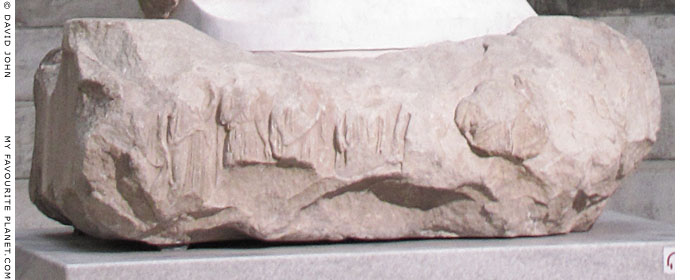
The badly damaged remains of the base of the statue of Athena Parthenos.
The relief is thought to have depicted deities attending the birth of Pandora.
Pergamon Museum, Berlin. |
| |
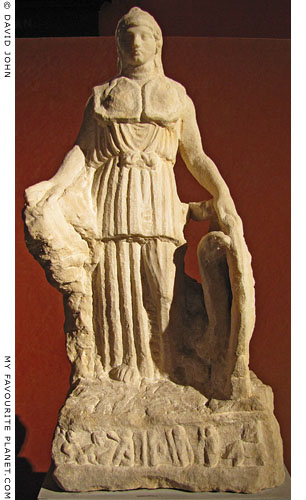
The "Lenormant Athena" statuette of Athena
Parthenos, miniature replica of Pheidias' statue.
2nd - 3rd century AD. Pentelic marble.
Height 42 cm. The statuette is unfinished,
and details such as the Pandora relief on the
front of the base, have been crudely blocked in.
Found west of the Pnyx, Athens, 1859. [4]
National Archaeological Museum,
Athens. Inv. No. 128.
photo: © David John |
|
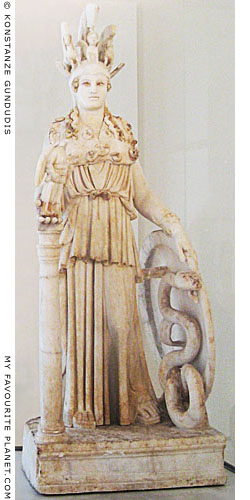
The "Varvakeion statuette" copy of the
Athena Parthenos statue by Pheidias.
Pentelic marble, 2nd - 3rd century AD.
Height with base 104.5 cm.
Found in 1880 near the Varvakeion
School, Psychiko, Athens. [5]
National Archaeological Museum,
Athens. Inv. No. 129.
photo: © Konstanze Gundudis |
|
| |
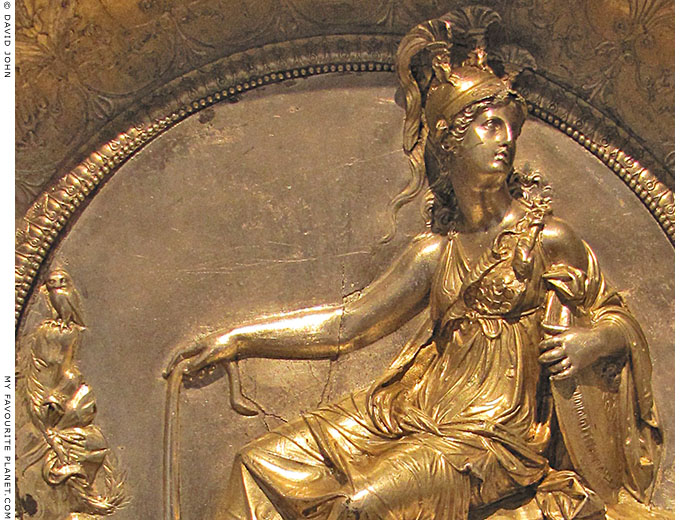
Detail of a relief of Athena / Minerva and her owl on a gold-plated silver plate. 2nd century BC.
The relief shows Athena (or her Roman equivalent Minerva) seated and wearing the triple-crested
helmet known from the Athena Parthenos statue by Pheidias. Around her left shoulder and breast
she wears the aeigis. In her left arm she holds a shield on which is the head of the Gorgon Medusa.
The tiny owl, the glaux, (see Athens Acropolis gallery, page 29) stands on a high rocky pinnacle
draped with a victory wreath.
For more information about Athena's aegis, see previous page.
It is thought that the relief was made in the 2nd century BC, and added to the plate during the time
of Emperor Augustus (63 BC-14 AD). It is part of a hoard of Roman tableware of the 1st century BC -
1st century AD, known as the "Hildesheim silver treasure", discovered in 1868 in Hildesheim, Germany.
Now in the Altes Museum, Berlin. Inv. No. Misc. 3779, 1-73. |
| |
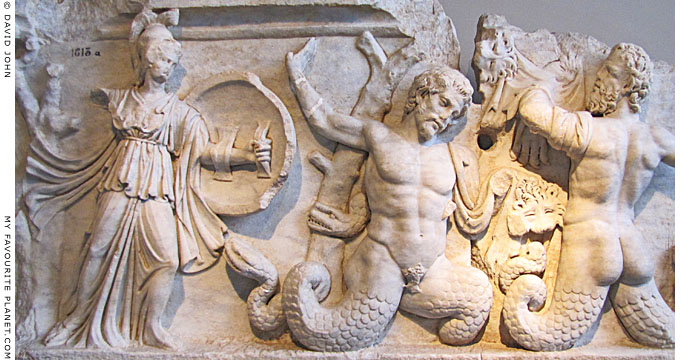
Detail of marble gigantomachy (battle of the Greek gods with the Giants) relief
showing Athena fighting the Tritons.
Athena is in full fighting gear, with a crested Corinthian helmet, aegis and shield.
Presumably she held a spear in her right hand, which is now missing.
From Aphrodisias (Geyre, Aydin, Turkey). 2nd century AD, Roman Imperial period.
Istanbul Archaeological Museum, Inv. No. 1613 a T. Cat. Mendel 512. |
| |
Pergamon
Library
Athena statue |
Notes, references and links |
 |
|
1. The discovery of the Athena Parthenos statue at Pergamon
1. See: Franz Winter, Altertümer von Pergamon, Band VII, Text I: Die Skulpturen, mit Aussnahme der Altarreliefs. pages 33-46. (The antiquities of Pergamon, Volume 7, Text 1: The sculptures, with the exception of the Altar reliefs). Königliche Museen zu Berlin. Verlag von Georg Reimer, Berlin, 1908.
2. Pausanias on the statue of Athena Parthenos
Pausanias, Description of Greece, Book 1, chapter 24, sections 5-7. English Translation by W. H. S. Jones and H. A. Ormerod. Harvard University Press, Cambridge, MA; William Heinemann, London. 1918.
At Perseus Digital Library.
3. Pliny on Pheidias and the statue of Athena Parthenos
"That Pheidias is the most famous sculptor among all peoples who appreciate the fame of his Olympian Jupiter is beyond doubt, but in order that even those who have not seen his works may be assured that his praises are well-earned, I shall produce evidence that is insignificant in itself and sufficient only to prove his inventiveness.
To do so, I shall not appeal to the beauty of his Olympian Jupiter or to the size of his Minerva at Athens, even though this statue, made of ivory and gold, is 26 cubits in height. But rather, I shall mention her shield, on the convex border of which he engraved a Battle of the Amazons, and on the hollow side Combats of Gods and Giants; and her sandals, on which he depicted Combats of Lapiths and Centaurs. So truly did every detail lend itself to his art.
On the pedestal there is carved what is entitled in Greek the Birth of Pandora, with twenty gods assisting at the birth. Although the figure of Victory is especially remarkable, connoisseurs admire also the snake, as well as the bronze sphinx that crouches just beneath her spear.
These are things which should be stated in passing with regard to an artist who has never been praised enough. At the same time, they make us realize that the grandeur of his notions was maintained even in small matters.
Praxiteles is an artist whose date I have mentioned among those of the makers of bronze statues, but in the fame of his work in marble he surpassed even himself. There are works by him at Athens in the Ceramcicus; and yet superior to anything not merely by Praxiteles, but in the whole world, is the Venus, which many people have sailed to Cnidus to see."
Pliny's Natural History, Book XXXVI, chapter IV. Translated by H. Rackham, W.H.S. Jones and D.E. Eichholz. Harvard University Press, MA; William Heinemann, London. 1949-54. At masseiana.org. |
|
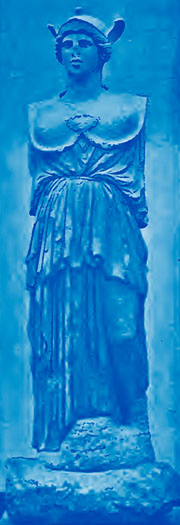
Photo of the statue of Athena Parthenos from Pergamon, taken before 1913, showing the figure with raised cheek flaps on the helmet.
Charles Heald Weller, Athens and its monuments, page 299. Macmillan, New York, 1913. |
|
| |
4. The Lenormant Athena
2nd - 3rd century AD. Pentelic marble.
Height 34 cm, with base 42 cm.
National Archaeological Museum, Athens. Inv. No. 128.
The "Lenormant Athena" (or "Athena Lenormant") statuette has been dated by some scholars to the 1st century AD, while others believe it was made in the 2nd or 3rd century. It is named after the French archaeologist Charles Lenormant (1802-1859), who first identified it as a replica of the Athena Parthenos statue by Pheidias in 1859.
After its discovery, the statuette seems to have been considered unimportant, and was placed in a corner of the Temple of Hephaistos (the Hephaisteion), which was then still known as the Theseion and used as a provisional museum 1834-1934 for the rapidly growing number of archaeological finds in Athens. Lenormant noticed it while visiting the Hephaestion with his son François Lenormant (1837-1883), who had accompanied him to Greece, and is said to have immediately recognized its importance. He informed the Greek government of his discovery, and Kyriakos Pittakis, Ephor of Antiquities, arranged to have the sculpture photographed by the Athenian photographer Calphas.
Charles Lenormant caught a fever and died in Athens in November of the same year, and his son wrote the first description of the statuette in his article La Minerve du Parthenon, published in the Gazette de Beaux Arts in 1860.
François Lenormant, La Minerve du Parthenon. Reprint of the article in French, published by L'Imprimerie de Jules Clave, Paris, 1860. At Googlebooks.
Although unfinished and of apparently poorer workmanship than the "Varvakeion statuette" (see below) , which was discovered twenty years later, this small sculpture was the first to be found which gave historians an idea of what the Athena Parthenos statue of Pheidias looked like; until then they only had written descriptions by ancient authors to go by. |
|
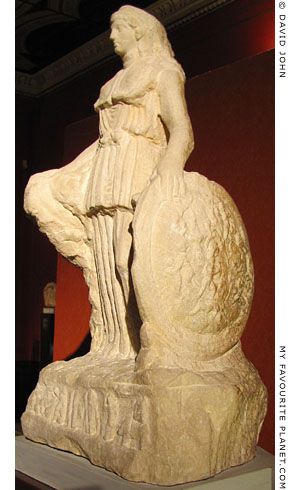
The left side of the Lenormant Athena,
showing the goddess holding the
shield with a relief of an Amazonomachy.
This photo and the one above were
taken in the Numismatic Museum,
Athens, when the statuette was on
loan for the temporary exhibition
"Myth and Coinage" in 2011. |
|
| |
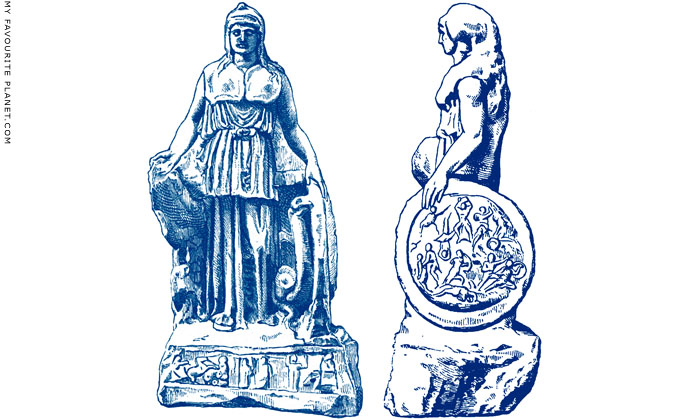
Drawings of The "Lenormant Athena" by Edmond Lechevallier-Chevignard (1825-1902).
From François Lenormant, La Minerve du Parthenon. Paris, 1860.
|
5. The "Varvakeion statuette" of Athena
Dicovered on 18 December 1880 near the Varvakeion
School, in the Athens suburb of Psychiko.
Total height 103.45 cm.
Plinth height 10.3 cm, width 41 cm,
depth left 28.5 cm, depth right 33.3 cm.
Nike figure height 14 cm (without head; estimated to have been 16 cm with head).
National Archaeological Museum, Athens.
Inv. No. 129.
See: Adolf Boetticher, Die Akropolis von Athen: nach den Berichten der Alten und den neusten Erforschungen, pages 163-170. Verlag von Julius Springer, 1888. |
|
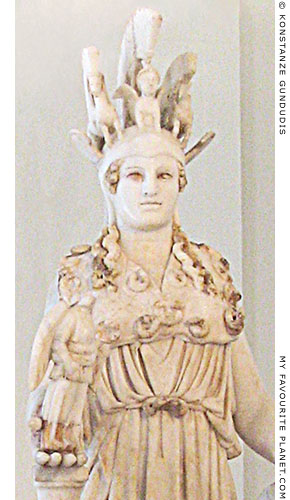
Detail of the Varvakeion statuette.
National Archaeological Museum,
Athens. Inv. No. 129. |
|
| |
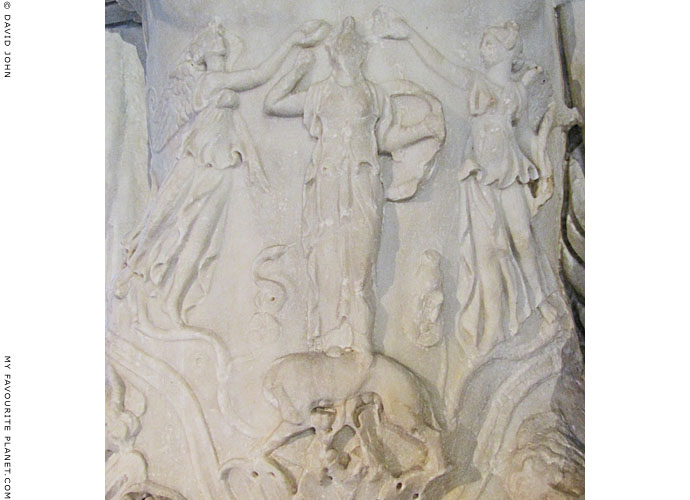
Marble relief showing Athena being crowned by two Nikes.
Athena wears a helmet and carries a shield held high. She also appears to be holding
a spear in her right hand. The goddess is flanked to her left by an owl, and to her right
by a snake. She stands on the back of an animal, presumably a wolf, which is suckled
by the small figures of Romulus and Remus (?) beneath it.
Detail from the cuirass of a colossal statue of Emperor Hadrian (76-138 AD,
reigned 117-138 AD). From Hierapitna, Crete. Made during the time of Hadrian.
Istanbul Archaeological Museum, Inv. No. 50 T. Cat. Mendel 585. |
| |
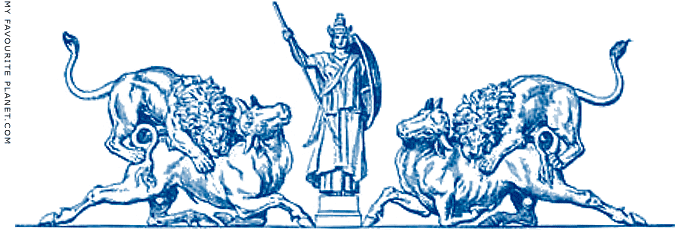
A statue of Athena flanked by a pair of sculptures of lions attacking bulls.
This image was used on the title page of the series of publications describing the results of
early archaeological excavations at Pergamon, produced by the Königliche Museen zu Berlin
(Royal Museums, Berlin, now the State Museums, Berlin, SMB). |
Maps, photos and articles: © David John,
except where otherwise specified.
Additional photos: © Konstanze Gundudis
All photos and articles are copyright protected.
Images and materials by other authors
have been attributed where applicable.
Please do not use these photos or articles without permission.
If you are interested in using any of the photos for your website,
project or publication, please get in contact.
Higher resolution versions are available on request. |
| |
 |
Visit the My Favourite Planet Group on Facebook.
Join the group, write a message or comment,
post photos and videos, start a discussion... |
|
|
| |
|
|
|